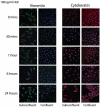Expression of hepatocyte growth factor and its receptor met in Wilms' tumors and nephrogenic rests reflects their roles in kidney development
- PMID: 19318497
- PMCID: PMC2682776
- DOI: 10.1158/1078-0432.CCR-08-1898
Expression of hepatocyte growth factor and its receptor met in Wilms' tumors and nephrogenic rests reflects their roles in kidney development
Abstract
Purpose: Hepatocyte growth factor (HGF) and its receptor Met are known to play diverse roles in both organogenesis and cancer. Wilms' tumor (WT) is a prototype for the link between abrogated development and neoplasia, with dysregulation of growth factor/receptor pathways playing key roles. Despite this, an understanding of the HGF/Met axis in the process is lacking.
Experimental design: Observing copy number alterations at the loci for these genes in WTs and their precursor lesions nephrogenic rests, we examined protein expression by immunohistochemistry and investigated the effects of HGF on an in vitro model of kidney development.
Results: HGF was preferentially expressed in the blastemal cells of nephrogenic rests but not WTs. Met expression was infrequent and restricted to well-differentiated epithelial cells and stroma in both lesions. In an independent cohort of favorable histology WTs on a tissue microarray, HGF was expressed in 15 of 193 (8%) cases and correlated with a predominance of epithelial cells, whereas Met expression was observed in 25 of 179 (14%) cases and was associated with stromal subtypes. In a mouse mesonephric cell line model, we observed Met expression in culture conditions reflecting both mesenchymal and epithelial differentiation, whereas HGF was up-regulated in association with acquisition of a more epithelial-like phenotype. This could be mimicked by exogenous exposure of mesenchymal-like cells to recombinant HGF.
Conclusions: These data show that the relatively infrequent expression of HGF and Met in WT tumorigenesis reflects their roles in nephrogenesis, particularly the mesenchymal-to-epithelial transition, rather than a dependence on oncogenic signaling pathways.
Figures





References
-
- Horster MF, Braun GS, Huber SM. Embryonic renal epithelia: induction, nephrogenesis, and cell differentiation. Physiol Rev. 1999;79:1157–91. - PubMed
-
- Rivera MN, Haber DA. Wilms’ tumour: connecting tumorigenesis and organ development in the kidney. Nat Rev Cancer. 2005;5:699–712. - PubMed
-
- Schedl A. Renal abnormalities and their developmental origin. Nat Rev Genet. 2007;8:791–802. - PubMed
-
- Beckwith JB, Kiviat NB, Bonadio JF. Nephrogenic rests, nephroblastomatosis, and the pathogenesis of Wilms’ tumor. Pediatr Pathol. 1990;10:1–36. - PubMed
Publication types
MeSH terms
Substances
Grants and funding
LinkOut - more resources
Full Text Sources
Medical
Miscellaneous

